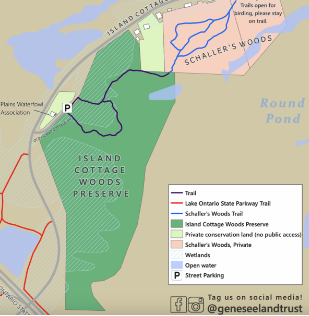In Rochester, summer can bring heat and dryness that can stress even the most resilient plants, but with a little care, you can keep your greenery flourishing and vibrant all season long. So take a moment to read about the importance of proper watering. Like humans, trees require water to stay healthy. Water is vital for many functions of the tree including photosynthesis, nutrient uptake, cell structure, and growth. Proper watering is essential to ensure your trees receive the hydration they need to thrive. 
Watering doesn't have to be done with fancy irrigation systems. A hose and time will get the job done just right! |
Proper watering means providing your trees with the right amount of water at the right time. It is recommended to water deeply, but infrequently, allowing the water to penetrate the soil and reach the tree's root system. This encourages more root growth and helps trees become more resilient to drought. In our area, where summers can be warm and dry, it's recommended to water your established trees deeply once every other week, depending on weather conditions, soil moisture, and age and species of tree. Some tree like Willows can thrive in swamps with their roots submerged almost year-round, while some Oak varieties will develop extensive root rot if the soil they are growing in stays wet for too long. A slow, steady flow of water is best, allowing it to soak into the ground and reach the tree's roots. Mulching around the base of your trees can help retain soil moisture and reduce the need for more frequent watering. Remember to not apply mulch directly to the root flare of your tree! Checking your soil moisture levels and adjusting your watering schedule, as needed, will help ensure your trees are receiving the proper amount of water. 
Signs of root rot in trees include yellowing foliage, thinning canopy, branch dieback, and mushrooms around the base. Rotted black roots indicate advanced decay and may emit a foul odor. |
It's important to understand that over-watering can be just as harmful as under-watering for trees. When soil remains waterlogged for extended periods, it can create an anaerobic environment where roots struggle to breathe. This condition, called waterlogging, leads to root rot and can cause severe decline in trees. Over-watering can also wash away essential nutrients from the soil, a process known as nutrient leaching. Aside from these direct consequences, over-watering also makes trees more susceptible to a range of other problems. Excess moisture around the tree's root system can encourage the growth of pathogenic fungi and bacteria, leading to root diseases. This moist environment is attractive to certain pests, such as root-eating nematodes. 
Watering newly planted trees deeply and regularly, especially during the first growing season, will help promote root growth and establishment. |
The amount of water and the frequency of watering will depend on various factors, including the type of tree or shrub, its size, soil type, and weather conditions. As a general guideline, newly planted trees often require more frequent watering until their root systems become established. Established trees have a more extensive root system and are better prepared to survive prolonged periods of heat and drought. The type of soil composition plays a role in how much watering your trees require; some soils retain water better than others. Observe your trees closely and pay attention to signs of stress, such as wilting leaves or yellowing of the foliage. 
Drought stress in leaves can manifest in various ways, and recognizing these signs is crucial for identifying and addressing water-related issues affecting trees. Common signs of drought stress includes: wilting, leaf curling, leaf yellowing, stunted growth, and browning on the edges of the leaves (leaf scorch). |
With the right care and attention, your trees and shrubs can thrive and beautify your landscape throughout the summer and beyond. Remember to water wisely, providing your trees with the moisture they need without overdoing it, and always keep an eye out for signs of stress or disease. If you have any questions about summer watering, tree care, or the specific needs of your trees and shrubs, do not hesitate to reach out to us. We're always here to help and provide expert guidance to ensure the health and longevity of your trees. Q: How can I tell if my tree is getting the right amount of water besides observing the leaves? A: Checking the soil itself is a really easy way to see if the tree is getting enough water. Something like a soil tensiometer could be used if you have one. Otherwise, it's still really easy to test. You can take something like a screwdriver and try to push it a few inches into the ground in the root zone of the tree. If it's easy to push into the soil your tree likely doesn't need watering. If it is hard to push into the ground, you should water your tree. Another way to tell is to dig a few inches into the ground and try to make the soil from the bottom of the hole into a ball. If the ball just crumbles apart, water your tree. If it's a muddy mess and can't be made into a ball, the tree has been over-watered. Q: What can I do if I over-water my tree? A: The number one thing to do if you over-water your tree is to stop watering it and to make sure you check the soil before watering again. You can also help improve the environment your tree is growing in by improving the condition of the soil. Clay soil is more compact so there is less macro pore space available to store water. Because of this, over-watering is more common in soils that have a heavier mixture of clay. You can help improve the soil by aerating the soil. This can be done manually or by amending the soil with organic matter such as compost. This will increase oxygen to the roots and increase bio activity in the soil. Improving the biology of the soil helps aerate the soil and will improve the tree's access to the nutrients available in the soil. Monster in the Neighborhood
As of October 1, 2023, the Genesee Land Trust closed the Island Cottage Woods Preserve (ICWP) to the community due to hazardous trees that caused a concern to public safety. Monster Tree Service of Rochester was thrilled to help Genesee Land Trust manage these 61 acres and aid in the mitigation of risk. Stage one of the project included the renovation of a walking and birding trail. Our team removed dead standing trees throughout the ICWP. The goal and guiding priority of this project was to drop as many hazardous trees as possible that were in striking distance of the trail. This project was so much fun for the team to work on. We look forward to working with the Genesee Land Trust on future projects! Find out more about the Island Cottage Woods Preserve. 
Which summer activity involving trees and water do you find the most fun?A. Tying a rope around a tree and floating on a tube B. Enjoying a picnic under the shade of a tree by water C. Camping by water D. Hiking in the woods along the path of water |
|
|
|
|
|
|
|
|
|
|









